Tabernas’ Desert
INDEX
-
INTRODUCTION
FAUNA
FLORA
GEOLOGY
-
CURIOSITY
-
Introduction
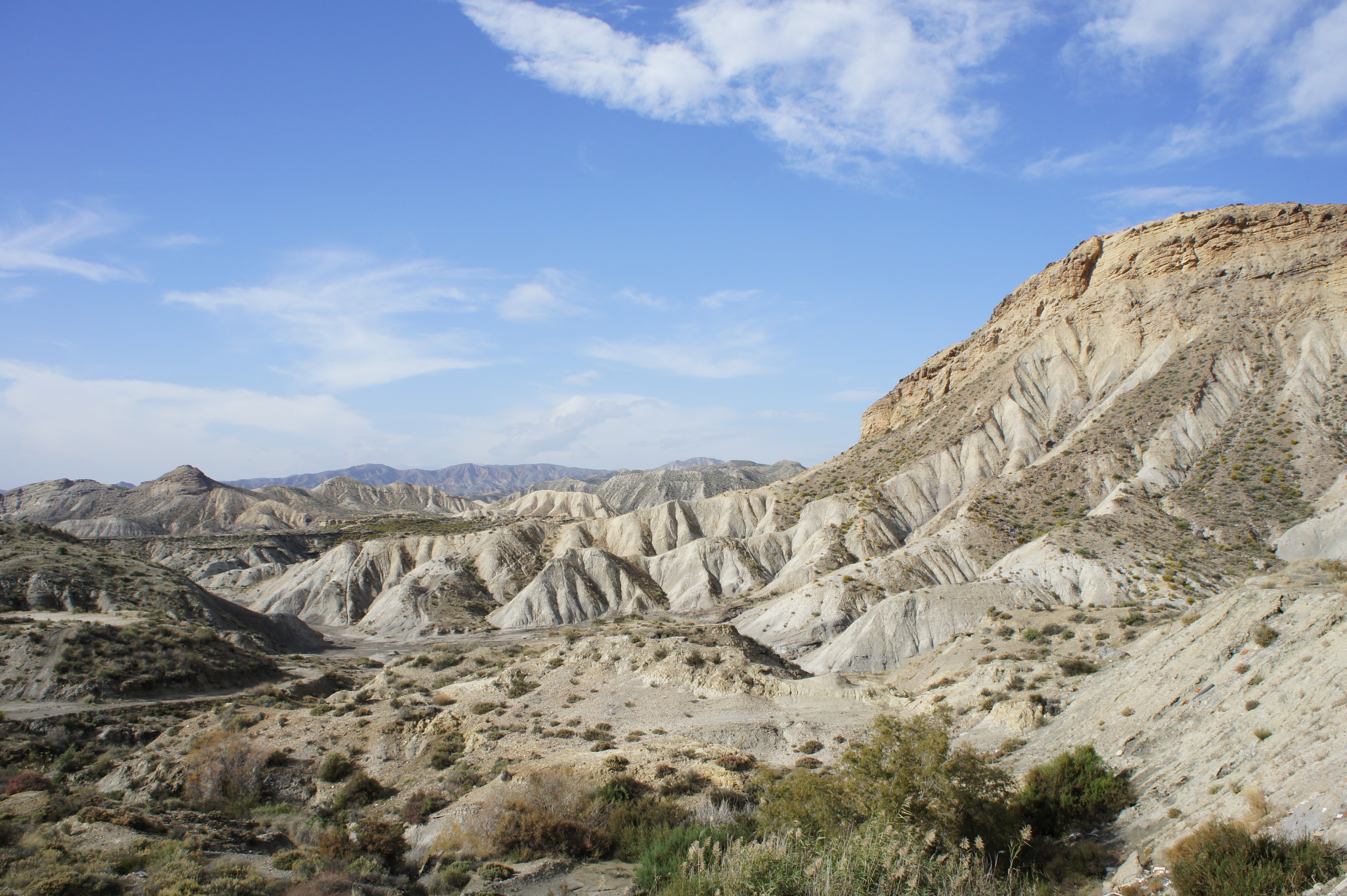 Tabernas’s desert is located to approximately30 km to the north of the capital in the municipal districts of Tabernas, Gádor, SantaCruz, Alboloduy and Gérgal, between the saws of Filabres and Alhamilla, which isolate it of the humid currents of the near Mediterranean Sea. This Natural Place have an extension of 280 km2. It is the only area considered desert in the strict sense in the whole European continent.
Tabernas’s desert is located to approximately30 km to the north of the capital in the municipal districts of Tabernas, Gádor, SantaCruz, Alboloduy and Gérgal, between the saws of Filabres and Alhamilla, which isolate it of the humid currents of the near Mediterranean Sea. This Natural Place have an extension of 280 km2. It is the only area considered desert in the strict sense in the whole European continent.
Fauna

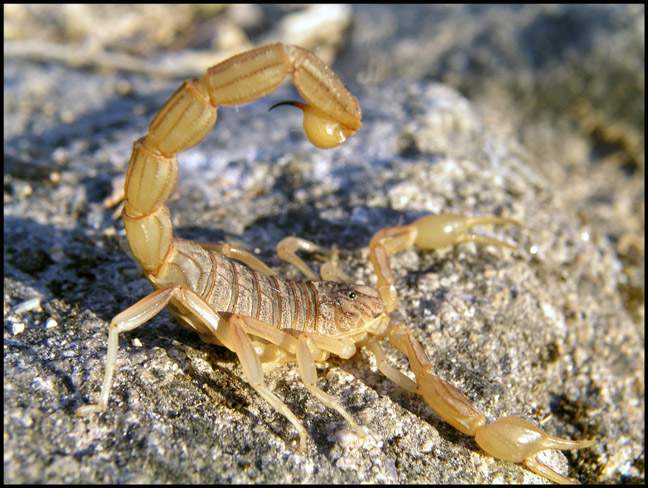 The fauna of the Tabernas’ natural desert has adapted itself to the climatic conditions and of the area, so that the biggest plenty happens in the most humid areas as the boulevards.
The fauna of the Tabernas’ natural desert has adapted itself to the climatic conditions and of the area, so that the biggest plenty happens in the most humid areas as the boulevards.
We can find birds like jackdaws, goldfinches, kestrels, owlets, sparrows, the bullfinch trumpeter, pigeon Zurita, Redpartridges, or peculiar hawks and eagles, which although they usually live in Saw Alhamilla, use the Tabernas’ desert as a fighter area.
As for terrestrial, less numerous animals. We can find foxes, rabbits, hares, hedgehogs, or dormice.
Also there exists big variety of snakes, toads, frogs, lizards and insects likes corpions, grasshopper, cicadas, bees, bee-eaters.
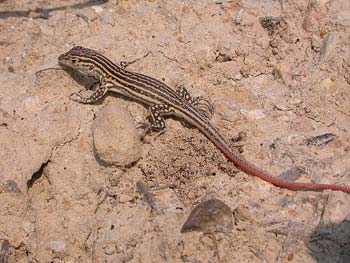
 The lizard colirroja is indigenous.
The lizard colirroja is indigenous.
FLORA
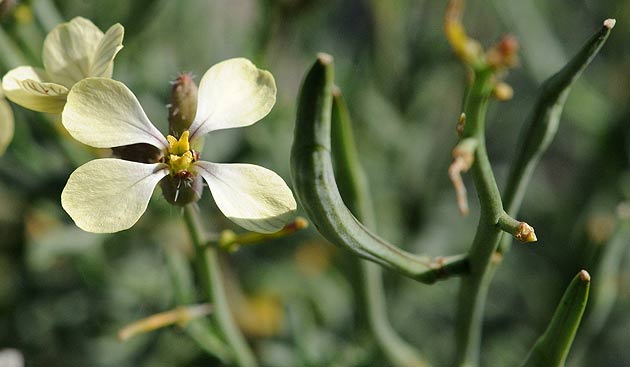
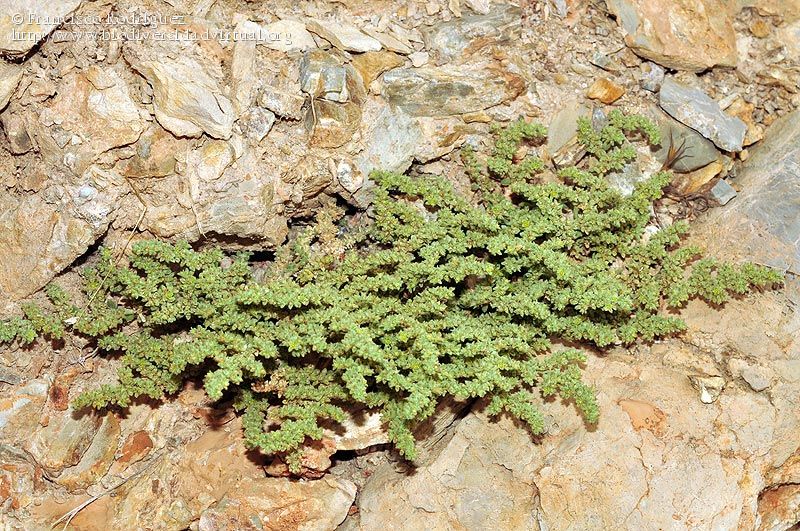 The flora, it presents a high number of exclusive endemics of the area, iberonorteafricanismos and rare species on a global scale, which only appear in him and in other points of identical characterization. We can find two exclusive series of vegetation on subsaline marls and on plasters.
The flora, it presents a high number of exclusive endemics of the area, iberonorteafricanismos and rare species on a global scale, which only appear in him and in other points of identical characterization. We can find two exclusive series of vegetation on subsaline marls and on plasters.
The domineering vegetation are tomillares with predominance of quenopodiáces and plumbagináceas. The typical species would be Euzomodendrombourgeanum, Anabasis articulata,distinguished Limonium, Salsola papillosa,Klasea leucantha, Atractylis humilis,Launaea lanifera, Helianthemumalmeriense, Herniaria fontanesii subspalmeriana, Frankenia corymbosa.
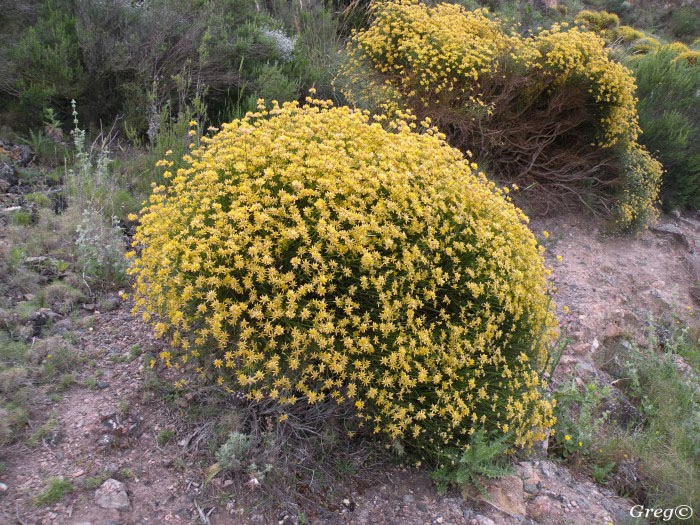
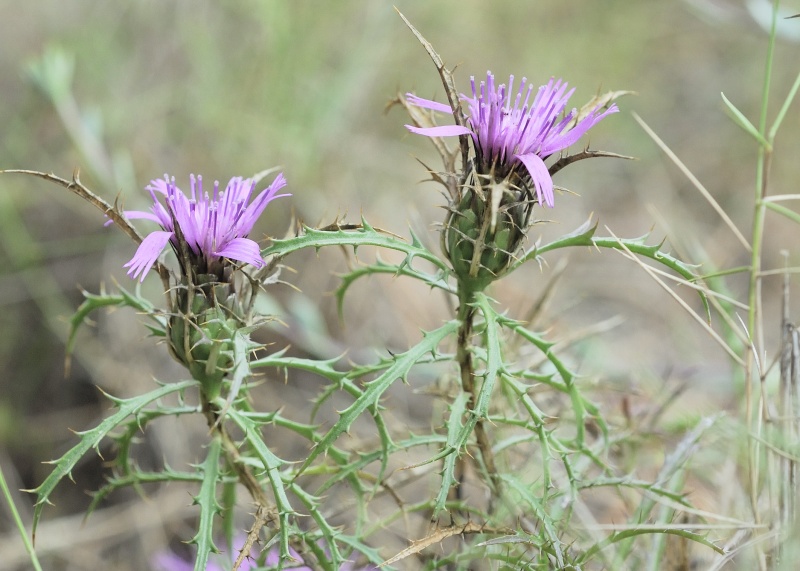 Species accompanists: Salsola genistoides,Asparagus horridus, Teucriumeriocephalum subsp. almeriense, Lygeumspartum, Dactylis glomerata, Stipaparviflora, Hammada articulata, Fagoniacretica, Stipa tenacissima, Artemisiabarrelieri, rock Phagnalon, Limonium tabernense.
Species accompanists: Salsola genistoides,Asparagus horridus, Teucriumeriocephalum subsp. almeriense, Lygeumspartum, Dactylis glomerata, Stipaparviflora, Hammada articulata, Fagoniacretica, Stipa tenacissima, Artemisiabarrelieri, rock Phagnalon, Limonium tabernense.
In soft hillsides Broom puts its color noteumbellata.
Some endemic and threatened plants that we can find are Moricandia foetida(Collejón), Caralluma europaea, Linarianigricans, Cynomorium coccineum,Rosmarinus eriocalix, Cistanche phelypaeasubsp lutea, Senecio flavus, Koelpinialinearis or Gypsophila struthium.


GEOLOGY
The BAD LANDS that compose this scenery are a set of cárcavas, boulevards, ravines, gorges and plains of austere vegetation submitted to continuous processes of serious erosion. Placed on tertiary and quaternary materials (for approximately 30million years proceeding from the depression formed by the broker Tabernas, Sorbas.
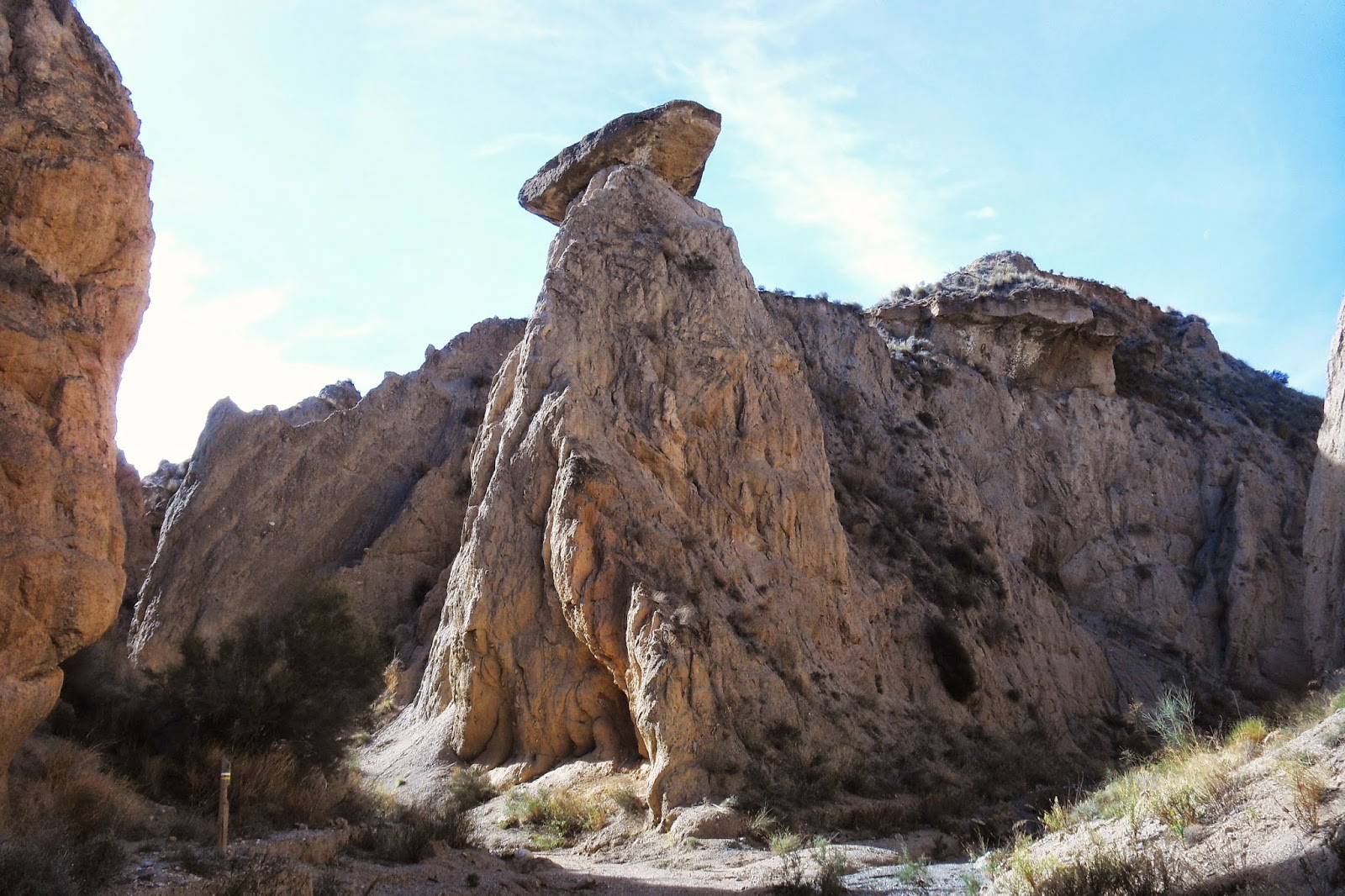
They emphasize the sandstones, the marlsand the conglomerates of marine origin, and the scarce depth of its soils there constitute factors limitants of its vegetable carpet. On the other hand, the gravels, the clays and the sand that settle in the bed of the boulevards, where the moisture contrasts with the surrounding dryness promote the establishment of different communities of fauna and flora.
The beds of the boulevards are covered of sand and gravels, while in the patios the slimes and clays are the predominant materials. The presence of sandstones and conglomerates crowning the highest reliefs propitiates the existence of cornices that they emphasize on the monotony of the softest materials.
On the marly sedimentary substratum atypically desert vegetation develops and xerofítica that represents the most arid vegetable formation of Europe, without covering even 40 % of the substratum.
CURIOSITY
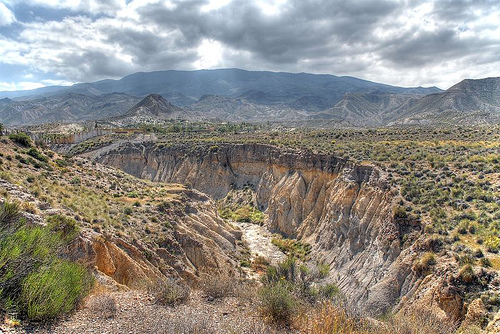 The Tabernas basin is constituted by free sediments, highly salinity and capable of being easily dragged by the rain water. This fact joined the scarce vegetation and the torrential rains, did that the soils of these areas were eroding almost completely, there being excavated big cárcavas and ravines separated by hillsides of strong earrings. In these hillsides, the erosion is intense and it allows the rooty of few vegetable species,therefore they are often naked and give to the set of the scenery the characteristic desert aspect.
The Tabernas basin is constituted by free sediments, highly salinity and capable of being easily dragged by the rain water. This fact joined the scarce vegetation and the torrential rains, did that the soils of these areas were eroding almost completely, there being excavated big cárcavas and ravines separated by hillsides of strong earrings. In these hillsides, the erosion is intense and it allows the rooty of few vegetable species,therefore they are often naked and give to the set of the scenery the characteristic desert aspect.
Go back to the section
 Tabernas’s desert is located to approximately30 km to the north of the capital in the municipal districts of Tabernas, Gádor, SantaCruz, Alboloduy and Gérgal, between the saws of Filabres and Alhamilla, which isolate it of the humid currents of the near Mediterranean Sea. This Natural Place have an extension of 280 km2. It is the only area considered desert in the strict sense in the whole European continent.
Tabernas’s desert is located to approximately30 km to the north of the capital in the municipal districts of Tabernas, Gádor, SantaCruz, Alboloduy and Gérgal, between the saws of Filabres and Alhamilla, which isolate it of the humid currents of the near Mediterranean Sea. This Natural Place have an extension of 280 km2. It is the only area considered desert in the strict sense in the whole European continent.
 The fauna of the Tabernas’ natural desert has adapted itself to the climatic conditions and of the area, so that the biggest plenty happens in the most humid areas as the boulevards.
The fauna of the Tabernas’ natural desert has adapted itself to the climatic conditions and of the area, so that the biggest plenty happens in the most humid areas as the boulevards.
 The lizard colirroja is indigenous.
The lizard colirroja is indigenous.
 The flora, it presents a high number of exclusive endemics of the area, iberonorteafricanismos and rare species on a global scale, which only appear in him and in other points of identical characterization. We can find two exclusive series of vegetation on subsaline marls and on plasters.
The flora, it presents a high number of exclusive endemics of the area, iberonorteafricanismos and rare species on a global scale, which only appear in him and in other points of identical characterization. We can find two exclusive series of vegetation on subsaline marls and on plasters.
 Species accompanists: Salsola genistoides,Asparagus horridus, Teucriumeriocephalum subsp. almeriense, Lygeumspartum, Dactylis glomerata, Stipaparviflora, Hammada articulata, Fagoniacretica, Stipa tenacissima, Artemisiabarrelieri, rock Phagnalon, Limonium tabernense.
Species accompanists: Salsola genistoides,Asparagus horridus, Teucriumeriocephalum subsp. almeriense, Lygeumspartum, Dactylis glomerata, Stipaparviflora, Hammada articulata, Fagoniacretica, Stipa tenacissima, Artemisiabarrelieri, rock Phagnalon, Limonium tabernense.


 The Tabernas basin is constituted by free sediments, highly salinity and capable of being easily dragged by the rain water. This fact joined the scarce vegetation and the torrential rains, did that the soils of these areas were eroding almost completely, there being excavated big cárcavas and ravines separated by hillsides of strong earrings. In these hillsides, the erosion is intense and it allows the rooty of few vegetable species,therefore they are often naked and give to the set of the scenery the characteristic desert aspect.
The Tabernas basin is constituted by free sediments, highly salinity and capable of being easily dragged by the rain water. This fact joined the scarce vegetation and the torrential rains, did that the soils of these areas were eroding almost completely, there being excavated big cárcavas and ravines separated by hillsides of strong earrings. In these hillsides, the erosion is intense and it allows the rooty of few vegetable species,therefore they are often naked and give to the set of the scenery the characteristic desert aspect.